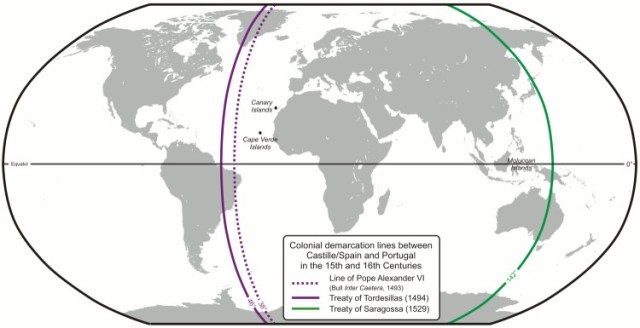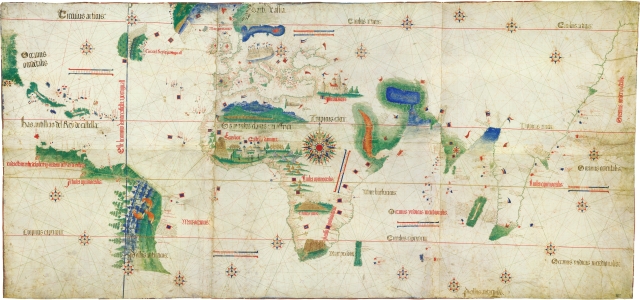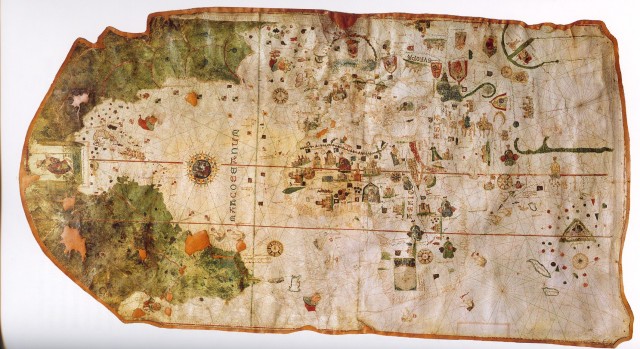
The 7th June marks the 525th anniversary of the signing of the Treaty of Tordesillas. The treaty was named for the Castilian town near Valladolid where it was signed by the Catholic Kings (Isabella I of Castile and Ferdinand II of Aragon) and John II, King of Portugal. The signing of this treaty divided those parts of the world newly “discovered” by Spain and Portugal between the empires of the two kingdoms along an imaginary meridian 370 leagues west of the Cape Verde islands. The lands to the east of this line corresponded to Portugal and those to the west to Spain.
The Treaty of Tordesillas had a precedent, the Treaty of Alcáçovas (1479), that followed the War of Castillan Succession, and already marked the division of the Atlantic into two spheres of influence, one for Spain and the other for Portugal, with the exception of the Canary islands (Spanish, but in the Portuguese sphere). This was confirmed by the papal bull Aeterni regis (Sixtus IV, 1481) which recognised as Portuguese some disputed territories in the Atlantic (Guinea, Madeira, Azores and Cape Verde). More importantly, the treaty recognised Portugal exclusive right of navigation south of the Canary islands.
A new treaty was necessary because of Portuguese aspirations in the New World, where the Spanish had first arrived in 1492. Consequently, the Spanish-born Pope Alexander VI had given Spain, through four bulls issued in 1493, the exclusive right to newly explored territories west of the meridian (at that time 100 leagues west of the Cape Verde Islands). Portugal was not satisfied with the division, arguing that they required a larger area in order to navigate their territories using the technique “volta do mar“.

The treaty stipulated that in the ten months following the signature, both parties should send one or two ships each with a team of experts to determine the established line of division. Ultimately, no further decisions were taken and the line of division remained problematic, because the treaty did not state a precise location for it. It was difficult at the time to establish it due to differing calculations and interpretations. As you can see below, the Tordesillas treaty’s line of division was marked in an early map known as a Cantino planishere (1502).

It is worth pointing out that both Iberian powers led the world in oceanic navigation at the time (publishing cartography, navigation charts and important early treatises on navigation), and, as a result, came into competition during the Age of Discoveries of the 15th and 16th centuries. The Castilian Crown financed and organised the expedition of the first global circumnavigation (1519-1522) by Ferdinand Magellan (Portuguese-born) and Juan Sebastián Elcano, completed by the latter. Interestingly, Portugal tried to stop them on several occasions. Needless to say, other European nations did not recognise this treaty, eventually following their own colonial ambitions.
Both Spain and Portugal continued their explorations in their respective spheres of influence. However, a new conflict began when both powers arrived in the Far East, and wished to gain control of the Moluccas (known as the Spice Islands), and the territory’s lucrative spice trade. Spain had arrived first, on the Magellan-Elcano expedition, and claimed the right of discovery, but Portugal argued that the territory fell into their sphere according to the Treaty of Tordesillas.

The Treaty of Zaragoza was signed on 22 April 1529 by King John III and the Emperor Charles V, in order to solve the dispute over the Moluccas. It did not modify the agreement of Tordesillas, but it added another line of division on the east, 297.5 leagues east of the Moluccas, leaving the Eastern part to Spain and the Western part (which included the Moluccas) to Portugal. However, to reach this agreement Portugal had to pay 350,000 ducats in gold to Spain, in order that the Spanish renounce their rights over the Moluccas. There was a cancellation clause for Spain, in the event of returning the money to Portugal.
Spain retained control over the Philippines (named after the King Philip II, the son of Emperor Charles V), on the east side of the Zaragoza treaty’s line (see map above). Despite first arriving there before Philip’s reign began, it took several years and attempts for the Spanish to settle in the territory – thus why it was named after him. The expedition of Miguel López de Legazpi (1564) was fundamental to establishing the Philippines as a Spanish settlement, but even more important was that of the explorer Andrés de Urdaneta (1565), who found a return route from the Philippines to New Spain, creating a new trade route known as the Manila-Acapulco galleon, which operated for over two centuries. The application of the Portuguese navigational technique “volta do mar” was required in order to sail through this route.

Nevertheless, the Treaty of Tordesillas was in force until 1750, when it was superseded by the Treaty of Madrid – although it was meaningless for several decades (1580-1640) as a result of the Iberian union in 1580, when both the Spanish and Portuguese empires were inherited by the Spanish King Phillip II. The Treaty of Madrid signed on the 13th January 1750, mainly marked the borders between Brazil and Spanish America, recognising much of what is now Brazilian territory for Portugal, as well as the Philippines for Spain.
Among the consequences of the Treaty of Tordesillas (subject of 670:8.c.95.939), we can highlight Spanish expansion in the Americas, including vast territories of today’s continental USA – eventually encountering the opposition of other emerging European powers who founded colonies in North America (particularly France and Britain). Another consequence of the treaty was recognising Brazil as a Portuguese colony. Portugal was originally entitled only to the small far eastern part of today’s Brazil (see the map above), but they largely ignored this boundary and expanded much further to the west, something Spain disregarded and eventually accepted. Lastly we can mention Portuguese expansion in Africa during their colonial period.
The Treaty of Tordesillas (see digitalized Portuguese and Spanish versions) was considered historically important enough to be included in UNESCO’s Memory of the World Register in 2007. In addition, the treaty and its historical importance has been the subject of several works and conferences (some listed below), particularly in 1994, on the occasion of its 500th anniversary. The town of Tordesillas has a museum dedicated to the treaty in the two contiguous “Casas del Tratado” where it was originally signed, and where this year the document was exhibited for the first time in its place of origin.
Manuel del Campo
Further reading
-Cadete, Bernardino (ed.). Os descobrimentos portugueses no século XV : actas, II Simpósio de História Marítima [Lisboa 20-22 de abril de 1994]. Lisboa: Academia Da Marinha, 1999. 585:27.c.95.17
-Dawson, Samuel Edward. The lines of demarcation of Pope Alexander VI and the Treaty of Tordesillas, A.D. 1493 and 1494. Ottawa: J. Hope; Toronto: Copp-Clark, 1899. RCS.62c.333
-Fernandes Costa, Manuel. O descobrimento da América e o Tratado de Tordesilhas. Lisboa: Instituto de Cultura Portuguesa, 1979. 2011.7.554
-Museo Naval de Madrid. La exploración del Pacífico: 500 anos de historia [exhibition catalogue in Spanish & English]. Madrid: Ministerio de Defensa, 2013. 2015.10.512
-Nunn, George E. The diplomacy concerning the Discovery of America. Jenkintown [Pa.]: Tall Tree Library, 1948. Uc.7.1572
–O Testamento de Adão: Arquivos Nacionais, Torre do Tombo, Lisboa, Setembro-Novembro, 1994. Lisbon: Comissão Nacional Para as Comemorações Dos Descobrimentos Portugueses; Madrid: Sociedad V Centenario Del Tratado De Tordesillas, 1994. 9001.b.909
-Pino Abad, Miguel. El Tratado de Zaragoza de 22 de abril de 1529 como anticipo a la conquista de Filipinas. In Fernández Rodríguez, Manuela (ed.) Guerra, derecho y política: aproximaciones a una interacción inevitable, 2014, pp. 25-44. Available online.
-Ribot García, Luis Antonio (ed.) El tratado de Tordesillas y su época [congreso internacional]. Valladolid: Junta de Castilla y León, 1995. 3 vols.
-Schröter, Bernd; Schüller, Karin (eds.). Tordesillas y sus consecuencias : la política de las grandes potencias europeas respecto a América latina (1494-1898) : conferencia… Frankfurt am Main: Vervuert; Madrid: Iberoamericana, 1995. 670:8.c.95.939
-Serna, Mercedes (ed.) La conquista del Nuevo mundo: textos y documentos de la aventura americana. Barcelona: Castalia, 2012. 743:01.d.17.316
-Varela Marcos, Jesús. El Tratado de Tordesillas en la política atlántica castellana. Valladolid: Universidad de Valladolid, 1997. 582:32.c.95.194


Reblogged this on penwithlit and commented:
Fascinating and important too….
I totally agree, thank you.
Great post 🙂
Thank you. I think this treaty is little-known to the general public in the English speaking countries.